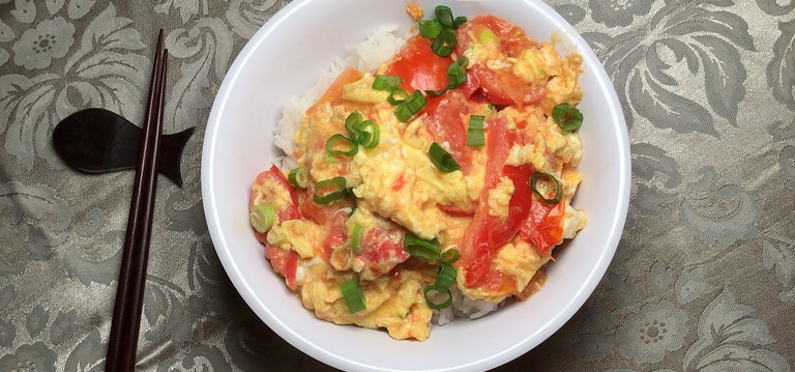
With only a few ingredients, Chinese Scrambled Eggs with Tomato (家常菜 - jia chang cai) is one of the easiest Chinese dishes to prepare. It's a staple in Chinese households and a particular favorite of Chinese students. Over the last couple of decades, we have hosted many international students in our home. Recently a majority of the students that have lived with us are from China. We always ask our students if they would like to cook a dish from their home country, and Chinese students have invariably chosen either Chinese Hot Pot or Scrambled Eggs with Tomato. Coming from a land that is famous for its huge repertoire of culinary delights, we have been surprised that most of the students we have hosted really didn't know how to prepare any other Chinese dish. While these dishes are exquisitely delicious, they both share one feature; they are incredibly easy to prepare. Chinese hot pot preparation is basically bring a broth to boil and toss in whatever ingredients you have bought. No special techniques involved, quite literally if you can boil water you have all the skill that is required. It is none-the-less a real culinary treat. Making Scrambled Eggs with Tomato is almost as easy, and unlike a good Hot Pot, have only a small number of ingredients—most likely you already have what is needed in your refrigerator!
We think the reason most Chinese students we have hosted share a lack of cooking experience cannot be reduced to notions that young people today just haven't learned proper survival skills, have no respect for traditions or are too busy with their social lives to learn how to cook or do anything else requiring practical everyday skills. It seems that the major reason for this break in tradition has to do with the academic rigors that face any college-bound Chinese students. Similar to what our Japanese students have told us about their school experiences, Chinese students say college is quite easy.
Getting there is not.
From the lowest grades of elementary or primary school until their senior year in high school, Chinese students spend an inordinate amount of time in school and participating in school-related activities. Indeed, in their final year of High School, practically the only thing Chinese students do is take practice tests. Not only is normal school experience filled with heavy workloads and high expectations, like quite a few other countries, high-pressure "cram schools" (buke) are the norm for most Chinese students. Another thing of note is that in China, "teaching to the test" is not only a common educational strategy, it is the only educational method. Every June high school students sit for the three day "Gaokao" college entrance exam. This exam will determine where a student will go to college and whether or not the will go at all. The exam only happens once a year. If you don't receive the minimal score, you must wait another year, and a few students take the exam multiple times before they achieve success. All of China shuts down for the Gaokao; factories are closed, honking car horns is forbidden, taxis are free for students and students have priority access to trains and buses. The exam differs if you are intent on studying liberal arts or science in college. Unlike here in the US, Chinese student very rarely change their majors once they start college. Some students we have known really disliked their majors, but remained in them because they didn't want to disappoint their parents. The Gaokao is not a modern invention but is based on a tradition that has existed for several millennium in China, namely the Civil Service Exam which was established in 650 CE and was in continuous operation until 1905! On the positive side, both the millennium-spanning civil service exam and the more recent Gaokao have provided a merit-based system that creates a path of social mobility. Indeed, even today, the Gaokao is more relevant to students living in rural and remote areas than it is for students from larger urban areas who have more financial resources to enable attending college outside of China. So no wonder Chinese students often don't know how to cook!
But as noted above, Scrambled Eggs with Tomato is not just something college students enjoy, it is a go-to comfort food (适食 - Shūshì shípǐn) in many Chinese homes.
There are only 3 basic ingredients for Scrambled Eggs with Tomato: Eggs, tomatoes, and rice. The variations on the dish tend to be additions to make the dish more savory or complex in flavor rather than adding more vegetables or protein sources. Shaoxing rice wine, ketchup, scallions, garlic, sesame oil, chili or chili sauce (our favorite the insanely popular Lao Ga Ma), soy sauce or ginger can be added to take the dish in a new and flavorful direction. Based on the suspect theory that sugar can reduce acidity, some recipes call for adding a teaspoon to the eggs. Personally, I think it is simply a matter that some folks like to add sugar to nearly everything they consume. Recently I had a restaurant pizza that had lots of sugar in the crust, and to my tastes it was nearly inedible. Traditionally Chinese Scrambled Eggs with Tomato is cooked in a wok, but any relatively non-stick pan or cast iron skillet will do just fine.
Perhaps nowhere in the culinary world is more contentious and contradictory than the advice given regarding the "proper" way to cook scrambled eggs. Some cooks (such as Julia Child) suggest using high heat, while many others contend that using a medium heat or the lowest heat possible is the secret to cooking great scrambled eggs. Some suggest that you should whip the eggs vigorously and for an extended period of time or simply lightly mix them with a fork (America's Test Kitchen), and lastly some recommend adding a "splash of water, milk or cream" on the theory that the steam generated in the scramble will make the eggs fluffier while others contend that that's simply poppycock. I think part of the confusion or debate is simply due to the fact that different people like different kinds of eggs, and you should follow a method that results in eggs that are to your liking. One person's fluffiness is another person's nebulous fluff, some like scrambled eggs that are wetter, some like them more substantial and firm, some like a concentration of flavor, others prefer a lighter taste. As always, experiment to find the texture you like and don't let anyone tell you what you should like (a general proposition applicable to all matters related to food!). However, one thing nearly all food writers and chefs agree on is that eggs continue to cook after they are removed from the heat, so remove them from the heat or skillet before they look fully cooked.
BR>Regarding tomatoes: Using fresh and flavorful tomatoes (such as the beefsteak, if you can find them) is probably best. You can skin them before you chop them or not (I don't mind the skins, but others do). Using drained canned tomatoes is a reasonable alternative and a bit more convenient (we always have canned tomatoes in our cabinet!). Some recipes call for lightly cooking the tomatoes while others suggest cooking them until they are mush. Again, it's up to you.
Lastly this recipe reverses the cooking process from most other recipes I found online. All of the recipes I found called for cooking the eggs first and then setting them aside and adding them back into the cooked tomatoes or adding the tomatoes to the cooking eggs. My own preference is to cook the tomatoes first, as I believe that this method offers a great deal more control because you are not adding cooled, already solidified eggs to the tomatoes.
Ingredients:
- 6 eggs
- 1/2 teaspoon sesame oil (optional)
- 1 tablespoon Shaoxing rice wine (optional)
- 1 pound fresh tomatoes roughly chopped or a 14.5 ounce of diced canned tomatoes, drained.
- 4 tablespoons vegetable oil
- 3 scallions, sliced thin
- Whatever other spices or flavorings you wish to add (see above for suggestions)
- Salt (to taste)
- Rice, for serving
Preparation:
- Crack eggs in a bowl, combine with sesame oil, salt and Shaoxing wine and then gently whisk to combine. Set aside.
- Cut tomatoes into wedges, or drain canned tomatoes.
- Slice the scallions thinly.
- On medium heat, sauté the tomatoes and scallions (reserving a portion for a garnish) together in 2 tablespoons of the oil (note options mentioned in the text above).
- Set aside the cooked tomatoes and scallions in a bowl.
- Wipe out pan and add the remaining oil to it.
- On medium heat, scramble to eggs using a combination of folding and stirring constantly. My preference is to create larger chunks of scrambled egg rather than small pebbles.
- When the eggs are almost done, add the tomatoes back into the pan and give everything a good stir.
- Garnish with the remaining scallions and serve the eggs over hot rice (traditional), cooked noodles (not uncommon) or even toast (scandalous!).
Enjoy!
Recipe by T. Johnston-O'Neill
Photos by Shari K. Johnston-O'Neill








